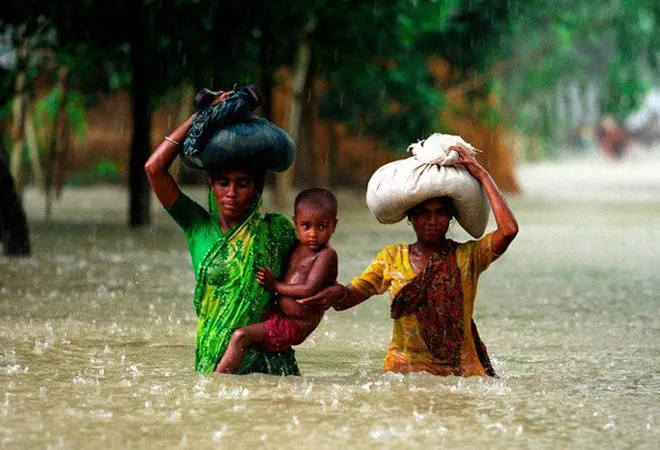
Natural calamities know no borders. This statement also holds true even for the effects of climate change. However, there are two fundamental fallacies in such an assertion. First, climate change is a far larger and more complex phenomenon than the calamities of nature, and second, the effects of the climate catastrophe are anything but evenly distributed. The question of who is affected by this crisis, and to what extent, is determined by one's socioeconomic position and is exacerbated by preexisting inequalities. One such inequality that we attempt to trace in this piece is that of gender.
The poor in the world are the most disadvantaged in terms of facing the consequences of the climate crisis, and according to a UN report from 2009, women, by them constituting the majority of the world's poor, are the most vulnerable in this regard. To trace why women are disproportionately affected by the perils of climate change, there are two linkages we need to explore: Firstly, how climate change adversely affects human beings, and secondly, why do women have to bear the brunt?
The direct impacts of climate change are the ones more researched and evident and include the adverse effects of rising temperatures, frequent weather fluctuations, and resource scarcity on human health, lives and livelihoods.
Human experiences of climate change
The impact of climate change on human lives is manifold and is both direct and indirect. The direct impacts of climate change are the ones more researched and evident and include the adverse effects of rising temperatures, frequent weather fluctuations, and resource scarcity on human health, lives and livelihoods. However, it is not only humans who are at the receiving end of the climate crisis but also the world around them, which includes other species, infrastructure, and access to food, health, and sanitation. Climate change has also been linked with an increase in infectious diseases, growing food insecurity, and the destruction of infrastructure, which directly impacts the quality of lives people lead. The propensity of these effects, however, is aggravated by the social norms and roles one assumes, and gender, being a key marker of such roles, becomes a primary factor in the distribution of these consequences.
Why are women selectively disadvantaged?
The disproportionate adverse effects that women are subjected to can be attributed to many different factors. Women are the primary dependents on natural resources and are responsible for securing food, water, and fuel for the households, and therefore are more vulnerable. Data from the India Human Development Survey-2 (IHDS), a national-level household survey on multiple development parameters, shows that women spend twice the amount of time (46 minutes) fetching water per day as compared to men (22 minutes). Whilst being more engaged in environment-related activities, women have less control over such resources and have limited decision-making powers when it comes to the distribution of such resources and of management benefits for the crisis (for example, relief packages provided by the government), rendering them incapable of confronting environmental catastrophes. A report by Climate Action Network shows that women perform additional 12–14 hours of work due to climate displacement and migration. In times of food shortages due to unfavourable weather conditions, it is the women who sacrifice and eat less than the men due to gender-biased expectations of altruism. According to the World Health Organization (WHO), women also suffer higher mortality and a larger decrease in life expectancy during, and after, extreme weather events. Climate change disproportionately harms women due to their marginalised identities and, at the same time, increases the risk of widening such disparities.
Women are the primary dependents on natural resources and are responsible for securing food, water, and fuel for the households, and therefore are more vulnerable.
Experiences from India
The impact of climate change in India is becoming more and more evident every year, with intensifying heat waves, erratic monsoons, calamities related to weather, and frequent droughts. However, the use of a gender lens in assessing the impact of climate change has brought into the limelight stories from India, which reassert the selective vulnerability of women to the climate crisis. A study of the tea plantations in Darjeeling, West Bengal, finds that in the last few years, the excessive use of fertilisers in the production of tea (a need that arose due to climate and ecological deterioration) has severely affected female tea workers, for they constitute the cheaper source of labour in tea gardens. They have suffered vision loss, skin infections, loss of appetite, and breathing ailments. Women form the majority of the agricultural workforce in rural India, a field which is especially vulnerable to climate change. Despite their vast knowledge and experience, they continue to hold very limited land-owning rights and minimal financial resources, which put them at a disadvantage in mitigating any climate-related crisis. Another report from Bihar, studying the impact on women in the aftermath of floods finds increased incidence of domestic violence against women, higher instances of trafficking in the name of marriage, increased preference for male children, and instances of abuse in the flood relief camps. The case of water wives in rural Maharashtra shows yet another link between climate change and an increase in women's exploitation. To address this problem of water scarcity arising from droughts and improper water connectivity, the men of the village have started taking on more wives, where the role of these wives is only to make sure that there is water in the house. Women from the poorest rural communities spend almost two and a half months in a year only fetching water, and there has been an increase in the distance women travel and the number of households which travel for water. We see again that women's gender roles and gender inequality put them at a higher disadvantage against the climate crisis.
Women from the poorest rural communities spend almost two and a half months in a year only fetching water, and there has been an increase in the distance women travel and the number of households which travel for water.
The way forward
Gender equality is both, a component of the sustainable development goals (SDGs), and, at the same time, a precondition for achieving sustainability. In addressing the urgent crisis of climate change, it is now crucial to acknowledge the gender dimension of its impacts, and for that to be reflected in the policy frameworks. Women should be at the centre of developing sustainable technologies so that their adaptiveness is ensured. Further, more gender-sensitive investments need to be made to develop infrastructures to cope with this crisis. All climate change-related programmes need to have a gender component, and progress should be closely monitored. Apart from systemic redressals, there is also a need for encouraging small-scale and focused responses. In Africa, a women's collective named ‘Solar sisters’ is trying to create small solar grids to reach energy efficiency. International green funding organisations should create a mandatory section in their applications about how the use of the funds will impact women and how they will be incorporated into the programme. Instead of solution-based responses, there is a need for a population-based response to this crisis, where women are seen as agents with their own set of needs, limitations, and contexts, and the policies for mitigation are designed accordingly. If at all we want to carry forward our struggle for decreasing gender gaps, we need to take into account the gender-specific impacts of this crisis and equip women, who are at the forefront of this battle, to mitigate harm.
The views expressed above belong to the author(s). ORF research and analyses now available on Telegram! Click here to access our curated content — blogs, longforms and interviews.




 PREV
PREV

